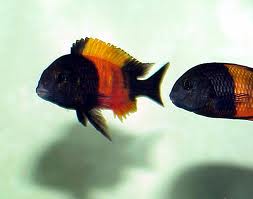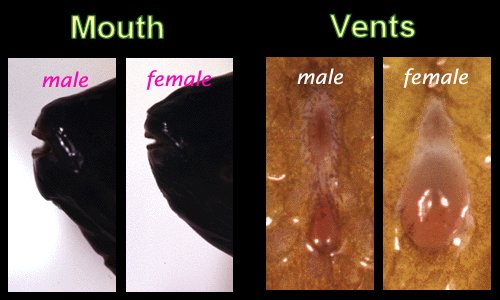
Common name: Tropheus Bemba Orange, Tropheus Pemba
Scientific name: Tropheus sp. Bemba
Average Adult Fish Size: 15cm / 6 Inches
Place of Origin: Lake Tanganyika
Typical Tank setup: Rocky Tanganyika tank
Recommended Minimum Aquarium Capacity: 200 Litres
Compatibility: Tropheus cichlids should really be kept with other Tropheus however the following are also compatible:
- Petrochromis
- Julidochromis
- Lamprologus
- Spathodus
- Eretmodus
- Tanganicodus
- Mbuna Malawi Cichlids
Take a look at our guide to keeping Tropheus cichlids with other fish.
Temperature: 24-27 Deg C / 74-79 Deg F
Water chemistry: pH 7.6-8.6
Feeding: Spirulina-based flake food supplimented with fresh green vegetables such as romaine lettuce and spinach.
Sexing: Males tend to have a turned-up nose while females tend to have a greater slope and rounded nose. Males will also grow at a faster rate (generally) and display their adult colors sooner. Males’ coloration is also often more bold than females’ because they like to show it off when courting females. Adult males will also tend to have a deeper body, whereas females appear more slim and streamline. While these characteristics may help an experienced hobbyist, venting is the only sure way to determine gender with Tropheus.

Breeding: Males are quite territorial and are aggressive in their attempts to coax females to spawn. They never seem to tire of this either – males want to spawn every minute of the day. This fish should never be kept in 1:1 ratios. One male to three or four females is an ideal ratio, but keep in mind that the only correct way to keep this species in captivity is in a group of ten or more individuals. The most difficult challenge to breeding Tropheus is bringing the females into spawning condition.
Additional Information: Even though Tropheus species are hearty, keeping them is not without challenges. The Tropheus fish can be the most rewarding of cichlid to keep though due to the rich colouration and constant activity of the fish. The Bemba Orange Tropheus is easily recognised by the thick orange band around the body of the cichlid. Almost as popular as the Tropheus Ikola however not as commonly found in the trade however still popular and easy enough to come by if you shop around.
Although the first Tropheus Bemba was reported to be imported in to Europe as far back as 1958, further shipments didn’t occur until 1976. First discovered by “Marlier” in 1959, the Tropheus Bemba is found in the northern part of Lake Tanganyika along the north west coast of the Congo.
Juvenile Tropheus Bemba often exhibit broken orange bands and no clear distinction between the band and the body however when more mature and reach adulthood the band should become much more solid and distinct.
The Tropheus Bemba collection point real name is actually Pemba so the Bemba may occasionally be referred to as Pemba however this is less common these days.


Related Posts
Croaking Gourami – Trichopsis vittatus
Benthochromis Tricoti
Large-eyed Mouthbrooder – Callochromis Macrops